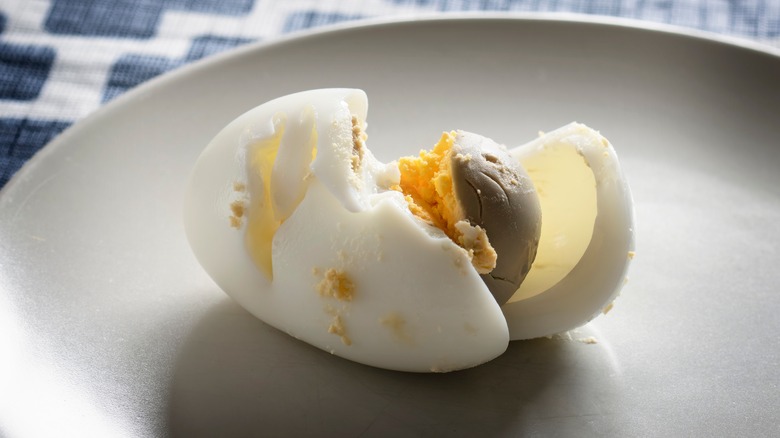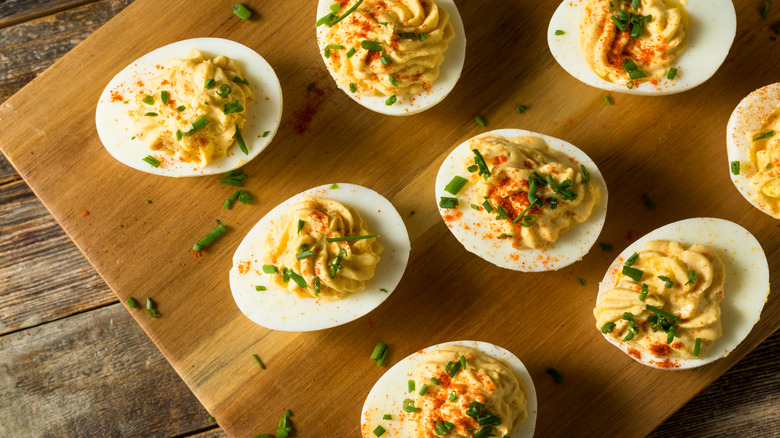How To Easily Get Rid Of That Unwanted Green Yolk On Your Hard-Boiled Eggs
The hacks for perfect hard-boiled eggs are endless. There are how-tos for easy peeling, innovative cooking techniques, and unexpected tools that can help achieve the desired result. But how exactly can you prevent the unsightly green or green-gray ring that can sometimes develop around the yolk? Its chalky consistency and less-than-appealing hue can quickly ruin a batch of hard-boiled eggs. Plus, let's face it: No one actually wants green eggs with their ham. Turns out, with just a few easy adjustments to your cooking time and heating intensity, that unwanted green yolk is history.
Overcooking is the reason for those pesky green yolks, and the key to prevent that is to find the sweet spot for hard-boiling. The egg authorities vary somewhat on this point, with the American Egg Board advising 12 minutes and the USDA recommending 12 to 15 minutes, depending on the size of the egg. Most sources are consistent on one point, though. Immediately running cold water over the eggs after cooking or dunking them in an ice bath will boost your odds of a perfectly hard-boiled egg with no green in sight. The cold acts as a shock that puts an end to the cooking process.
The process couldn't be easier. Still, there are a few things you'll want to keep in mind to achieve the best results.
The shocking science behind the green ring
To properly shock your eggs, choose a metal bowl for better temperature regulation and large ice cubes if possible since they'll melt slower. Depending on the number of eggs cooked, consider submerging them for 15 minutes. Once they've chilled, the shells should come off effortlessly.
Congratulations! You've got yellow yolks. But what causes the greenish-gray discoloration anyway? It's the result of a chemical reaction between the sulfur in the egg whites and the iron in the yolk. This reaction, first studied in 1920 by researchers C.K. Tinkler and M.C. Soar, causes the change in color and texture, and is known as "ferrous sulfide formation." To put it plainly, egg whites are made up of sulfur-containing compounds. When these compounds are heated during the cooking process, they release hydrogen sulfide gas. The longer the eggs are cooked, the more hydrogen sulfide gas is produced. This gas is also responsible for that lovely rotten egg smell.
Meanwhile, the yolk contains iron, specifically ferrous ions. When the hydrogen sulfide gas produced by the whites mingles with the ferrous ions in the yolk, it forms ferrous sulfide, a greenish-gray compound. This formation is responsible for the yolk's discoloration. The reaction is likelier to occur the longer the eggs are subjected to high levels of heat, so overcooking is a main culprit. Although the USDA says green-yolked hard-boiled eggs are perfectly safe to eat, they are certainly not as flavorful or visually appealing as a perfectly hard-boiled egg.
Ways to flaunt your yellow yolks
With cook time under control and a quick change of temperature post-cooking, you're bound to have perfectly yellow yolks. Now what to do with them? For starters, you can't go wrong with classic egg salad, a simple yet satisfying dish with just a hint of nostalgia. Pair those hard-boiled eggs with creamy mayo, tangy mustard, and a dash of zesty lemon juice and add some diced pickles for added texture. Finish it off with a garnish of fresh parsley, salt, and pepper and enjoy it open-faced on a slice of sourdough or fully sandwiched on some brioche.
Another standby is deviled eggs. There are a lot of variations out there but sometimes it's best to stick with the original. This recipe pairs the star of the show, the perfectly yellow yolk from the hard-boiled egg, with mayonnaise and mustard and adds a nice zip of acidity in the form of sweet pickle juice. Top these bite-sized fan favorites off with salt, pepper, dried dill, and a little paprika and you're sure to have a crowd-pleasing appetizer.
For early risers, a hard-boiled egg stuffed biscuit is major morning upgrade. Ditch the classics and go for the showstopper with this breakfast on the go. A twist on the old ham, egg, and cheese sandwich, this recipe features buttery biscuits stuffed with a hard-boiled egg, sliced ham, and shredded cheese that combine to form a protein punch that is equal parts salty and savory.


